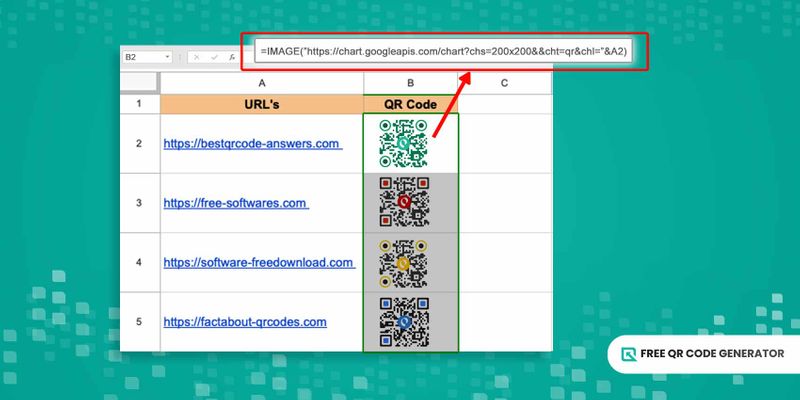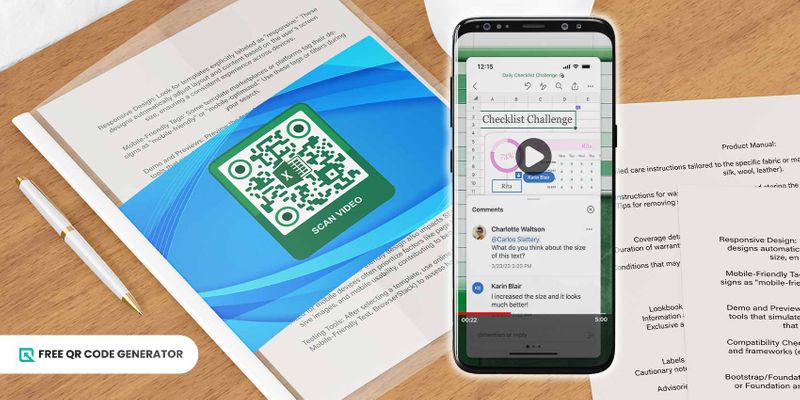How to Create a QR Code in Excel: A Beginner’s Guide

Did you know that you can create a QR code in Excel so you no longer have to crowd your sheet with multiple data?
Believe it or not, you can create QR codes within an Excel sheet or transform a whole Excel file into a QR code. Through a series of numbers, functions, and formulas, you can transform data and values into pixelated squares.
It offers an effortless way to generate a unique QR code for a long list of data by simply repeating the commands.
But here’s more: a free QR code generator can help you generate a QR code, too, less the complexity of formulas and commands. Read more below to learn this easy trick!
Table of Contents
- Can you create QR codes for Excel-related purposes?
- How do you generate a QR code in Spreadsheet?
- How to create a custom QR code for Excel with Free QR Code Generator
- Pros and cons of generating a QR code for Excel spreadsheet in Microsoft
- Maximize the capabilities of your spreadsheets with a QR code in Excel
- Frequently Asked Questions
Can you create QR codes for Excel-related purposes?

This might be a surprise to many, but it’s true that you can create a QR code for files within the Excel sheet itself.
To start creating Excel QR codes straight in the Excel sheet, you simply need to put data in a column. This data column can contain URLs, texts, files, social media pages, and more.
In another column, put the corresponding QR codes for the data in the first column.
If you want to create even more bespoke spreadsheets for your QR codes, you can add a column for the description, call to action, texts, and sizes of each QR code.
Curate your Excel sheet exactly as you want it.
How do you generate a QR code in Spreadsheet?
In most use cases, you can generate a QR code for Excel spreadsheet in two methods: an image function or a third-party add-in. The method that works best for you depends on the version of Excel you own.
Here’s a breakdown of how to generate a free QR code through these two methods:
Generate a QR code in Excel using the IMAGE function

If you own the new Excel for Microsoft 365, the easiest way to create QR codes in your spreadsheets is through the image function.
It is made possible through a QR code API (Application Programming Interface), which enables data exchange with external software and integration with a CRM system. For this reason, this method is often also called QR code API.
Here’s a step-by-step guide to generating a QR code using the image function.
1. Open a new Excel spreadsheet.
2. In Column A, place all the links, texts, and data to convert into QR codes.
3. In Column B, type this formula:
=IMAGE("https://api.qrserver.com/v1/create-qr-code/?size=150x150&data="&ENCODEURL(A2))
Breaking down this formula:
=IMAGE is the function that you command in Excel.
https://api.qrserver.com/v1/create-qr-code/? is the QR code API.
size=150x150 is the size of the QR code in pixels. The numbers can be adjusted based on your needs
&ENCODEURL(A2) is the instruction for the specific cell. In this example, it encodes A2.
Note: This formula may vary depending on the API you’re going to use. In general, the formula should always look like variations of =IMAGE("QR Code Generator URL").
4. Press Enter on your keyboard to generate the QR code in Excel.
5. Adjust the size of the cell to increase the size of the QR code. Drag the column line in a row or a column to resize the cell. You can also manually resize them by right-clicking the cell and typing specific numbers for the cell dimension.
Note: QR codes from the IMAGE function are embedded within the cell. By resizing the cell, you resize the QR code dimensions. However, it also means deleting the cell means deleting the QR codes.
6. Test its accuracy by pointing the smartphone or QR code scanner to Excel.
7. Once you verify that the QR code redirects to the correct value, click the circle at the corner of the cell with the formula.
8. Drag it down to the cell with the corresponding data in Column A.
9. Every value in Column A should be represented by a unique QR code.
Note: You cannot download or save the QR codes as image files when they’re generated using the IMAGE function.
A counterpart QR code for Word Document users also exists. A Word document QR code meant to store and share Word files, just like this Excel one.
Generate an Excel QR code using a third-party add-in

If you own an older Excel version, the most foolproof way to generate QR codes in your spreadsheet is through a third-party add-in.
Unlike QR code generation through the IMAGE function, which allows you to create in bulk, a third-party add-in works best for fewer value sets because you may need to create these QR codes one by one.
Nonetheless, it still works incredibly well to create a QR code in Excel. Here’s how.
1. Open a blank Excel spreadsheet.
2. Go to Insert.
3. Click Add-ins or Get Add-ins, depending on your Excel version.
4. Select the STORE option and then search for a QR Code Generator add-in.
5. Choose among the QR Code Generator add-in selections, check the permissions needed, and then click Continue.
6. Once you’ve successfully installed the add-in, it will open on the right-side panel.
7. Fill out the required requirements and then follow the instructions to create a QR code.
Note: The process may be different depending on the QR code generator add-in you select. If you’re unsure of its step-by-step process, select another add-in or contact its helpdesk.
8. Once done following the instructions of the add-in, insert QR code to Excel.
9. Double-check that the QR code redirects to the correct data by scanning it on your phone.
Once the data is verified, you can rearrange and resize the QR codes by placing the values in Column A and the QR codes in Column B.
Note: You can right-click the QR code to download it as an image in PNG format.
How to create a custom QR code for Excel with Free QR Code Generator

If, for some reason, the methods above don’t work, you can always create a QR code using third-party QR code software.
Since it isn’t directly connected with Excel, there are a few steps to generating a QR code file document management and manually adding them to the spreadsheet.
The great thing is that you can create these two-dimensional barcodes for FREE! Follow this step-by-step guide to get started.
1. Go to Free QR Code Generator online.
2. Select a specific QR code solution that fits your needs.
3. Enter the information.
4. Choose between Static and Dynamic QR codes.
Tip: Dynamic QR codes allow you to edit and track your scan data through in-platform analytics even after scanning them.
5. Customize the QR code design of your QR code in Excel by choosing from different colors and designs or adding a logo and frames with calls to action (60 characters max).
6. Check if the QR code is recognizable by scanning it first using your smartphone, then Download in PNG.
Note: PNG format should be readable for small footprints like Excel sheets. A QR code vector works better for large printed materials like posters and billboards.
7. Open a new Excel spreadsheet. Organize the values in Column A, and the QR codes in Column B. Revise the cells accordingly to make the QR codes recognizable.
Pros and cons of generating a QR code for Excel spreadsheet in Microsoft
Excel is free and easy to use. A lot of people use it every day, so there’s little to no learning curve for the most part.
Using Microsoft Excel to generate QR codes offers plenty of advantages, such as:
- Bulk QR code feature, perfect for creating a database for businesses
- Data validation as Excel notifies you if there are errors in the formula
- Data sharing for physical copies of QR codes and their corresponding values
- You can now use this code to monitor files or compile certain data, as in QR code asset tracking and inventory management that’s much easier to access.
However, using Excel is not without its disadvantages, too. Since it’s not a specialized QR code generator, it means missing out on features such as:
- Tracking and monitoring of the number of scans, locations, and devices used
- High-quality QR code generator to be scannable for print ads and billboards
- Customization features for colors, design, frames, and branding
Maximize the capabilities of your spreadsheets with a QR code in Excel
Microsoft Excel is more than just a computer program that allows you to calculate, compute, and macro-program numbers, data, formulas, and functions in spreadsheets.
This spreadsheet editor allows you to easily create QR codes through integrations like APIs, Excel add-ins, and QR code software—you just have to maximize its capabilities!
However, if you want to use QR codes to their full potential, your best bet is to use a trusted and secure online QR code generator. It also gives you the option to create bulk QR codes where you can track, monitor, and update the data in your QR codes.
Visit Free QR Code Generator to learn more.
Frequently Asked Questions
What is the formula for the QR code Excel?
The IMAGE function formula for this is =IMAGE("QR Code Generator URL"). The final formula depends on the API you will use to create the QR codes.
If you want a formula for creating QR codes in spreadsheets, use this formula: =IMAGE("https://api.qrserver.com/v1/create-qr-code/?size=150x150&data="&ENCODEURL(A2)).
What is the formula for Google Sheets QR codes?
Another popular spreadsheet maker and editor is Google Sheets. Similar to Microsoft Excel, this software allows you to create QR codes. You can use the same IMAGE function formula to generate a QR code in Google Sheets.
Similarly, you can also use QR code generator plug-ins to generate QR codes. The process is similar: you need to insert a QR code manually, rearrange the values, and resize the cells to make these 2D barcodes readable.
Can you use QR code to share Excel spreadsheets?
Of course! Simply go to Free QR Code Generator and then select the file QR code solution. You can attach the Excel file in CSV, XLSX, or XLB formats to generate a QR code.
